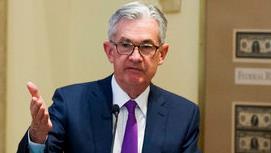US consumers spending rises strongly, inflation moderates
WASHINGTON (Reuters) - U.S. consumer spending increased by the most in seven months in October, but underlying price pressures slowed, with an inflation measure tracked by the Federal Reserve posting its smallest annual increase since February.
The strong consumer spending reported by the Commerce Department on Thursday probably keeps the U.S. central bank on track to raise interest rates next month for the fourth time this year. But moderating inflation, if sustained, could temper expectations on the pace of rate hikes in 2019.
Fed Chair Jerome Powell on Wednesday appeared to signal the central bank is nearing an end to its interest-rate increases, saying its policy rate was now "just below" a level that neither brakes nor boosts a healthy economy.
Powell has faced intense criticism from President Donald Trump, who has viewed the rate hikes as undercutting the White House's economic and trade policies.
"The Fed will be in a quandary if the deceleration in core inflation persists," said Roiana Reid, an economist at Berenberg Capital Markets in New York.
Consumer spending, which accounts for more than two-thirds of U.S. economic activity, jumped 0.6 percent last month as households spent more on prescription medication and utilities, among other goods and services.
Data for September was revised down to show spending rising 0.2 percent instead of the previously reported 0.4 percent gain.
Economists polled by Reuters had forecast consumer spending increasing 0.4 percent in October.
The personal consumption expenditures (PCE) price index excluding the volatile food and energy components edged up 0.1 percent after increasing 0.2 percent in September.
That lowered the year-on-year increase in the so-called core PCE price index to 1.8 percent, the smallest rise since February, from 1.9 percent in September.
The core PCE index is the Fed's preferred inflation measure. It hit the central bank's 2 percent inflation target in March for the first time since April 2012.
Minutes of the Fed's November policy meeting published on Thursday showed nearly all officials agreed another rate increase was "likely to be warranted fairly soon," but also opened debate on when to pause further hikes.
U.S. stocks were trading lower after Wednesday's rally, which was sparked by Powell's comments on interest rates. The dollar was little changed against a basket of currencies, while U.S. Treasury prices rose.
ECONOMY SLOWING
When adjusted for inflation, consumer spending advanced 0.4 percent in October, also the biggest gain in seven months and pointing to a solid pace of consumption early in the fourth quarter.
Despite the strong consumer spending, there are signs that economic growth is slowing. Data this month suggested a cooling in business spending on equipment, a deterioration in the trade deficit as well as further weakness in the housing market.
A separate report on Thursday from the Labor Department showed the number of Americans filing applications for jobless benefits increased to a six-month high last week, potentially hinting at a slowdown in job growth.
Initial claims for state unemployment benefits rose 10,000 to a seasonally adjusted 234,000 for the week ended Nov. 24, the highest level since the mid-May. Claims have now risen for three straight weeks. Difficulties adjusting the data around holidays such as Thanksgiving Day, could have boosted claims.
Economists said the increase in filings was unsurprising given the ongoing financial market volatility, the fading stimulus from a $1.5 trillion tax cut and the Trump administration's protectionist trade policy.
"We view the increase in claims as consistent with the recent increase in financial market stress and the ebbing in fiscal stimulus," said Michael Gapen, chief U.S. economist at Barclays in New York. "Gains in employment in the coming months should still be well above levels needed to keep the unemployment rate steady."
The unemployment rate is near a 49-year low of 3.7 percent. Job gains have averaged 212,500 per month this year.
Growth estimates for the fourth quarter are currently around a 2.6 percent annualized rate. The economy grew at a 3.5 percent pace in the July-September quarter.
In October, spending on goods surged 0.5 percent after gaining 0.1 percent in September. Outlays on services shot up 0.7 percent after rising 0.3 percent the prior month.
With wages rising modestly last month, the current pace of consumer spending is unlikely to be sustainable. Still, cheaper gasoline, thanks to tumbling oil prices, is seen supporting consumption as the boost from the tax cut wanes.
Last month, personal income increased 0.5 percent, the largest gain since January, after rising 0.2 percent in September. Income growth was probably driven by the government bailing out farmers caught up in the trade war between the United States and China.
Wages rose 0.3 percent in October, matching September's gain. Savings slipped to $967.8 billion last month, the lowest level since December 2017, from $976.9 billion in September.
"With special factors at work, the best we can conclude is that the consumer is still spending but households are not flush," said Joel Naroff, chief economist at Naroff Economic Advisors in Holland, Pennsylvania. "Unless wage gains accelerate, the early part of next year could be ugly as households cut back to pay for their holiday excesses."
(Reporting by Lucia Mutikani; Editing by Andrea Ricci and Susan Thomas)




















